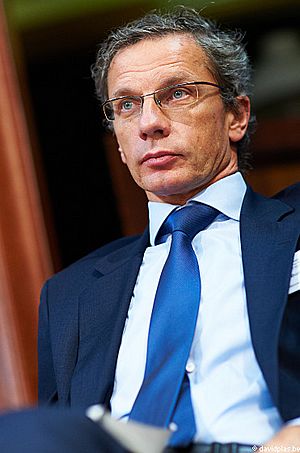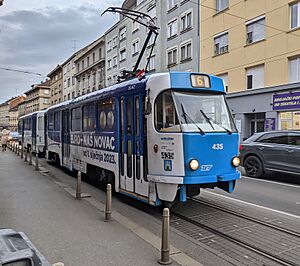Croatia and the euro facts for kids
Croatia started using the euro as its money on January 1, 2023. This made it the 20th country to join the eurozone, which is the group of European Union (EU) countries that use the euro. The exchange rate was set so that 1 euro was equal to 7.5345 Croatian kuna.
Before the euro, Croatia used a currency called the kuna. The word "kuna" means "marten" (a small animal) in Croatian. The kuna had been linked to the euro (and before that, the German mark) since 1994. The Croatian National Bank always tried to keep the kuna's value stable against the euro.
When Croatia joined the European Union (EU) on July 1, 2013, it agreed to adopt the euro. To do this, Croatia had to meet certain economic rules called euro convergence criteria. Boris Vujčić, who was the head of the Croatian National Bank, wanted Croatia to switch to the euro as soon as possible after joining the EU. This meant waiting at least two years after joining a special system called ERM II, plus meeting other rules. Croatia officially joined ERM II on July 10, 2020.
In November 2020, Prime Minister Andrej Plenković announced that Croatia planned to adopt the euro on January 1, 2023. The Croatian government then created a plan to make this happen. Many small businesses in Croatia already had debts in euros before the country joined the EU. People in Croatia also used euros for most of their savings and for many everyday payments. Prices for things like homes, cars, and places to stay were often shown in euros.
On July 18, 2022, the Croatian Mint started making Croatian euro coins with special Croatian designs.
Contents
Meeting the Euro Rules
To adopt the euro, countries must meet specific economic rules. These rules cover things like how stable prices are, how much debt the government has, and how interest rates behave.
In May 2014, Croatia was checked for the first time. It met some rules, like those for inflation (how fast prices go up) and interest rates. However, it did not meet the rules for government finances or for being part of the ERM II system. It also needed to change some laws. Later checks in 2016, 2018, and 2020 showed similar results.
Finally, a report in June 2022 confirmed that Croatia had met all the rules needed to adopt the euro.
Why Croatia Wanted the Euro
Joining the EU meant Croatia had to join the eurozone once it met the economic rules. Before Croatia joined the EU in 2013, Boris Vujčić, the head of the Croatian National Bank, hoped the kuna would be replaced by the euro very soon. This would happen at least two years after Croatia joined the ERM II, which is like a waiting room for countries wanting to join the euro.
The Croatian National Bank thought Croatia might adopt the euro within two or three years of joining the EU. However, financial problems in the eurozone at that time slowed things down. Croatia's own economy was also shrinking, which made it harder to meet the euro rules. Even though Croatia wanted the euro, Mr. Vujčić said in 2013 that there was "no date in mind" yet. The European Central Bank (ECB) thought Croatia might join ERM II in 2016 at the earliest, with the euro coming in 2019.
In April 2015, President Kolinda Grabar-Kitarović said she was sure Croatia would introduce the euro by 2020. But the Prime Minister at the time, Zoran Milanović, did not agree to that timeline.
In November 2017, Prime Minister Andrej Plenković said Croatia aimed to join ERM II by 2020 and introduce the euro by 2025. In June 2019, Jean-Claude Juncker, who was the President of the European Commission, said that "Croatia is ready to join the ERM-2."
Croatia took its first official step towards adopting the euro on July 5, 2019. The Finance Minister, Zdravko Marić, and the head of the Croatian National Bank, Boris Vujčić, sent a letter saying Croatia wanted to join the ERM II. Croatia also promised to join the Banking union of the European Union as part of this process. In November 2019, European Commissioner Valdis Dombrovskis said Croatia could join ERM II in the second half of 2020.
Croatia officially joined ERM II on July 10, 2020. The value of the kuna was set at 1 euro = 7.53450 kuna. This meant the earliest Croatia could adopt the euro was July 10, 2022, because countries need to be in ERM II for at least two years.
Aiming for January 1, 2023
On November 11, 2020, Prime Minister Andrej Plenković announced that Croatia planned to adopt the euro on January 1, 2023.
In June 2021, Prime Minister Plenković repeated that the government wanted to join the eurozone on that date. In September 2021, he said that Croatia had full support from the European Commission and the European Central Bank. Croatia also signed an agreement with the European Commission and eurozone countries about making Croatian euro coins. In December, Croatia and the European Commission signed another agreement to help inform people about the change from kuna to euro.
In November 2021, a political party called Hrvatski Suverenisti tried to get enough signatures to hold a public vote to stop the euro adoption, but they were not successful.
On December 10, 2021, Finance Minister Marić said that a law about introducing the euro was being prepared. He explained that on January 1, 2023, Croatia would switch to the euro overnight. For the first two weeks of January, people could pay with both kunas and euros, but after that, only euros would be accepted. Prices would be shown in both kunas and euros for at least one year.
In January 2022, Prime Minister Plenković announced that from September 5, 2022, prices would be shown in both kunas and euros. This dual pricing would continue throughout 2023. Also, in 2023, people could exchange kunas for euros for free at banks and post offices.
On May 13, 2022, the Croatian Parliament voted to approve the euro as the country's official money.
In May 2022, the European Commission finished its check of Croatia's progress. The final decision for euro adoption was made by the EU's ECOFIN council. This decision could not happen before July 10, 2022, which was two years after Croatia joined ERM II.
On June 1, 2022, the Commission said that Croatia met all the rules for joining the euro area and suggested that Croatia adopt the euro on January 1, 2023.
On June 16, 2022, the countries already using the euro recommended that Croatia become the 20th member. Paschal Donohoe, who was the head of the Eurogroup (the group of eurozone finance ministers), said he was "very pleased" that Croatia met all the conditions.
On June 24, 2022, the European Council supported the idea of Croatia adopting the euro. On July 5, 2022, the European Parliament also approved Croatia's entry into the eurozone with a large majority vote.
Finally, on July 12, 2022, the Council of the EU passed the last laws needed for Croatia to adopt the euro. The fixed exchange rate was set at €1 = kn 7.53450.
On July 18, 2022, the Croatian Mint began making euro coins with Croatian designs.
From September 5, 2022, until December 31, 2023, all prices had to be shown in both kunas and euros. This was to prevent businesses from unfairly raising prices. Starting December 1, 2022, people could buy euro starter kits to get used to the new coins. These coins could not be used before January 1, 2023.
For the first two weeks of January 2023, people could pay with both kunas and euros in cash, but they would receive change only in euros. After that, only euros were accepted for payments. Kuna coins could be exchanged at the Croatian National Bank until January 1, 2026. Kuna banknotes can be exchanged indefinitely.
Croatian Euro Coins
While the back side of euro coins looks the same across all countries, each country can choose its own special designs for the front side of the coins it makes.
The special designs chosen for the Croatian euro coins include the Croatian checkerboard pattern, a map of Croatia, a marten (the animal), Nikola Tesla, and the old Croatian writing style called Glagolitic script. These designs were chosen by the government in 2021. The Croatian National Bank held a competition for the designs in 2022. There were some disagreements about the designs, but the final choices were approved by the Council of the EU in April 2022.
Where Coins Were Made
- 2022: Croatian Mint
What the Euro Change Cost and Gained
The Croatian Ministry of Finance estimated that changing from the kuna to the euro would cost about 2 billion kuna (around €266 million). Most of this cost was due to banks losing money from currency exchange services, which might lead to higher banking fees for customers. There was also a chance that prices for everyday goods might go up, and people who had debts in other currencies might face risks.
By the end of 2023, the Ministry of Finance estimated that the economy saved about 160 million euros. This was because Croatia's credit rating improved, the risk of currency changes decreased, and transaction fees were removed. However, Croatia adopted the euro during a time when prices were already rising quickly (inflation). Some studies suggest that joining the euro might have caused a small increase in inflation, especially for clothing, food, and hospitality services. This might have happened because businesses rounded up prices when converting them from kunas to euros.
See also
 In Spanish: Croacia y el euro para niños
In Spanish: Croacia y el euro para niños
- Croatia in the European Union
- 2013 enlargement of the European Union
- Enlargement of the eurozone




